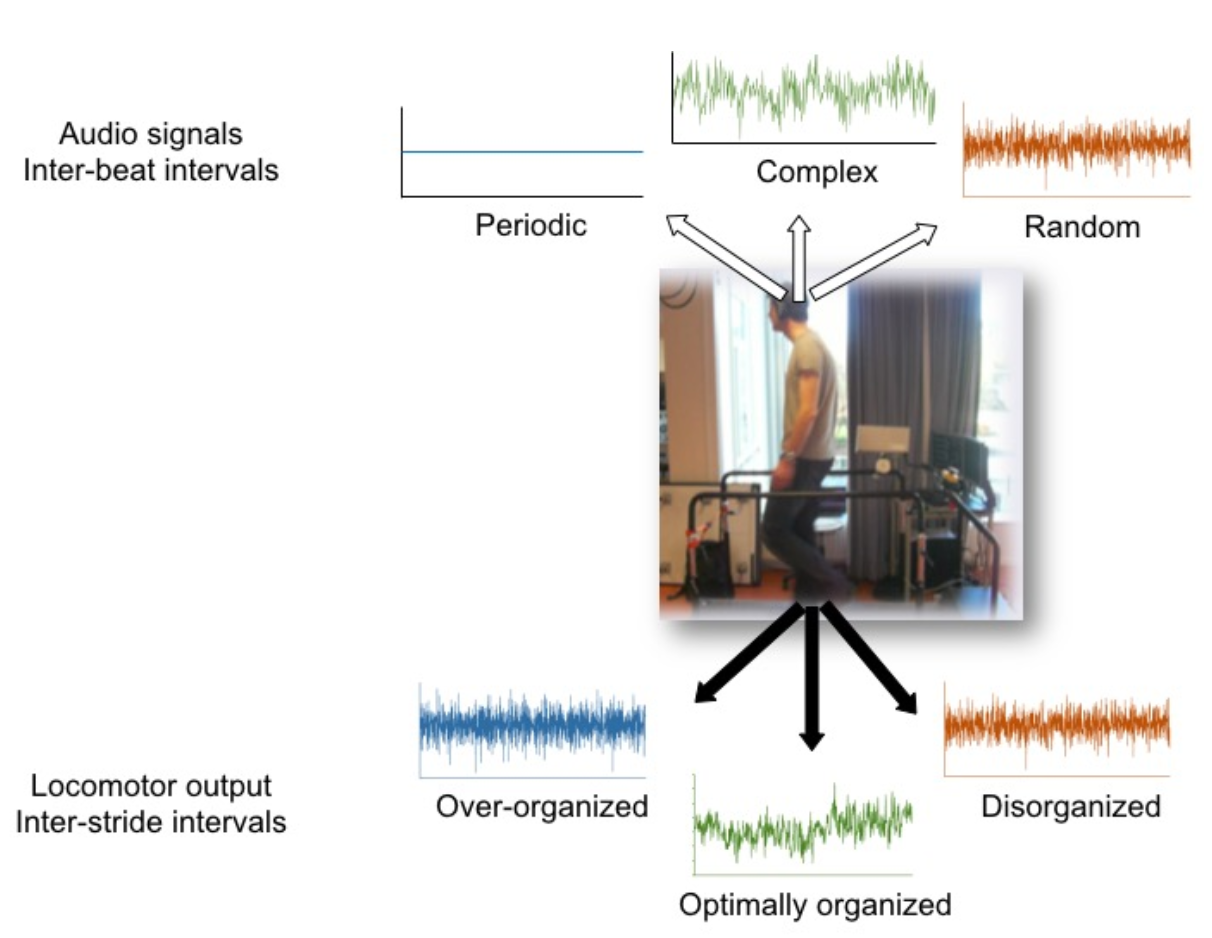Healthy locomotion is characterized by small fluctuations between strides. This stride-to-stride variability plays an important role in an individual’s ability to adapt to the environment. A system producing absolutely no variability -such as a robot- is unable to adapt its steps in response to an unexpected event in its environment. A system with a lot of random variability -such as a drunken sailor- is also unable to adapt to unexpected events due to the lack of organization between consecutive strides. The organization of gait variability, e.g. the relationship between consecutive strides over time, is therefore of interest for gait rehabilitation. Healthy stride-to-stride variability presents complex fluctuations and falls between over-organized, robotic gait and disorganized, drunken gait. It has been evidenced that aging and neurological diseases are associated with reduced organization of stride-to-stride variability and that people with a higher risk of falls display a reduced organization of stride-to-stride variability.
From this perspective, a critical aspect of gait rehabilitation should be to improve the organization of stride-to-stride variability. Periodic audio metronomes are non-invasive, cost-efficient tools that are widely used in gait rehabilitation to improve timing of gait. However, these periodic cueing devices lead to over-organization of stride-to-stride variability. We proposed to use innovative non-periodic audio metronomes to modify stride-to-stride variability toward different levels of organization. We designed an experiment in which healthy young adults were asked to walk on a treadmill while synchronizing their steps with audio metronomes. The time intervals between audio beats were either periodic or fluctuated in a random or complex pattern (Figure 1, upper panel).
 Figure 1: Representation of the protocol. Participants walked on a treadmill while synchronizing their steps to auditory metronomes with: no variability (blue), random variability (orange) or complex variability (green). Their stride intervals were recorded with a force platform embedded in the treadmill, and their gait was shown to be: over-organized (blue), disorganized (orange) or optimally organized (green).
Figure 1: Representation of the protocol. Participants walked on a treadmill while synchronizing their steps to auditory metronomes with: no variability (blue), random variability (orange) or complex variability (green). Their stride intervals were recorded with a force platform embedded in the treadmill, and their gait was shown to be: over-organized (blue), disorganized (orange) or optimally organized (green).
We were only able to see complex stride-to-stride fluctuations when the metronome also presented complex fluctuations (Figure 1, green panels). In the other conditions, walking variability was either over-organized (with the periodic metronome, in blue) or disorganized (with the random metronome, in red). Our results reveal that it is possible to modify gait variability toward desired levels of organization with non-periodic audio metronomes. Previous research has suggested that locomotion disorders experienced by patients with Parkinson’s disease (PD) improve when they walk with a periodic metronome. These results suggest that gait rehabilitation may benefit from using such novel metronomes, although their effect on gait adaptability needs to be examined. Non-periodic metronomes hold great promise for people with PD.
Publication
Marmelat V, Torre K, Beek PJ, Daffertshofer A (2014). Persistent fluctuations in stride intervals under fractal auditory stimulation. PLoS ONE 9(3): e91949. http://dx.doi.org/10.1371/journal.pone.0091949
About the Author

Vivien Marmelat, PhD
Department of Biomechanics, University of Nebraska at Omaha
The study presented here was part of his doctoral work at the Department of Human Movement Sciences, Vrije Universiteit Amsterdam, the Netherlands, and the Euromov institute, Montpellier University, France.
Vivien’s research focuses on understanding human movement variability using non-linear analysis. His main goals are the detection and treatment of movement disorders. He is currently leading different projects investigating complex audio cueing in subjects with Parkinson’s disease.
Copyright
© 2018 by the author. Except as otherwise noted, the ISPGR blog, including its text and figures, is licensed under a Creative Commons Attribution-ShareAlike 4.0 International License. To view a copy of this license, visit https://creativecommons.org/licenses/by-sa/4.0/legalcode.
ISPGR blog (ISSN 2561-4703)
Are you interested in writing a blog post for the ISPGR website? If so, please email the ISGPR Secretariat with the following information:
- First and Last Name
- Institution/Affiliation
- Paper you will be referencing
